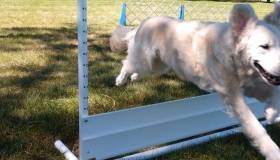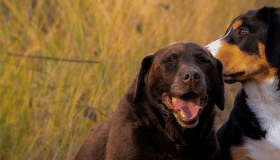
August 19, 2019 – Dr. Kelly Diehl talks again to Dr. Missy Simpson, Study Epidemiologist for the Morris Animal Foundation Golden Retriever Lifetime Study. The two discuss the first substantial findings of the Study, about how spaying or neutering large-breed dogs can put them at a higher risk for obesity and, if done when the dog is young, non-traumatic orthopedic injuries.
00:18 Dr. Kelly Diehl: Welcome to Fresh Scoop, Episode 11: New Information from the Golden Retriever Lifetime Study on Non-Traumatic Orthopedic Injuries in Young Dogs. I'm your host, Dr. Kelly Diehl, Morris Animal Foundation's Senior Director of Science and Communications, and today we're going to talk with Dr. Missy Simpson, our study epidemiologist for Morris Animal Foundation's Golden Retriever Lifetime Study. We hope you're learning some things with our episodes. For those of you who may be new, this is the monthly podcast of Morris Animal Foundation, one of the largest non-profit foundations in the world dedicated to funding studies to find solutions to serious health threats in animals. Founded in 1948 by Dr. Mark Morris Sr., a veterinarian, we've invested more than $126 million in more than 2,600 studies that have improved and protected the health of companion animals like cats, dogs, and horses, as well as wildlife. In each episode we'll feature one of the researchers we fund, or one of our staff members, discussing their work in advancing animal health.
01:30 DD: So, whether you're a practicing veterinarian, technician, or student, or just an animal loving science geek, Fresh Scoop is the podcast for you. You can learn more about us at morrisanimalfoundation.org. Okay, on to today's show. Today, for the second time and encore appearance, we welcome [chuckle] Dr. Missy Simpson, our staff epidemiologist for Morris Animal Foundation's Golden Retriever Lifetime Study. Dr. Simpson completed her veterinary degree at Colorado State University and obtained a PhD from the Colorado School of Public Health. She's here to talk about a paper she just published from our study regarding the timing of spay and neuter of golden retrievers and the health effects. Missy joined the Foundation four years ago. And for those of you who are familiar with our podcast series, you'll recall that Missy was our very first guest. And if you haven't heard her first podcast, especially if you want some background on the Study itself, I encourage everyone to take a listen. But Missy, thanks for speaking with us today.
02:36 Dr. Missy Simpson: Thank you for having me, it's my pleasure.
02:38 DD: So, a little bit... Before we get into your work, can you tell us... I mean I know I just introduced you, but tell us a little more about yourself and your background.
02:48 DS: Sure. In addition to what you already mentioned, I grew up here in Colorado on the Western Slope, and have lived here my whole life with the exception of a four-year adventure in northern Wisconsin.
03:03 DD: And for those of everybody that's listening, I know I introduced you as an epidemiologist, but could you kind of give everyone a definition of what an epidemiologist is?
03:15 DS: Well, literally epidemiologist means a study of what happens to people. But more generally, epidemiologists study patterns of disease in populations. Typically, people think of epidemiologists in the context of human health, but there's huge potential for an epidemiologist in veterinary health also.
03:40 DD: Great. So, I alluded to our earlier podcast where we talked about the Golden Retriever Lifetime Study, but we may have some new listeners. Can you give a brief overview of the Study?
03:53 DS: The Golden Retriever Lifetime Study started in 2012, and we enrolled about 3,000 dogs over the course of three years. The dogs were quite young when their owners enrolled them, so they were between eight weeks and two years of age when they started the Study. And we've just been following them since then, collecting data on them annually, and following them for important disease outcomes. We have four types of cancer that are of particular interest: osteosarcoma, lymphoma, hemangiosarcoma, and mast cell tumors.
04:31 DD: Great, and actually we're going to talk a little bit more about some of your latest research from the Study. Because as we're entering, as you mentioned, for some of our dogs their seventh year, we've got some data that's really accumulating that is meaningful. So, I know we just talked about you published your second paper, can you give us a quick overview first what it was focused on?
04:57 DS: The paper that was recently published is looking at the association between spaying and neutering and two important health outcomes for dogs. The first one is overweight and obesity, and the second one is non-traumatic orthopedic injuries. So, what we mean by that are orthopedic injuries that didn't happen because the dog was hit by a car or something like that. They are injuries that are more intrinsic to dogs.
05:27 DD: Why did you decide specifically to focus on overweight and obesity and age at neuter or spay?
05:35 DS: Well, overweight and obesity is a really important problem in our domestic dog population. In the Golden Retriever Lifetime Study, the prevalence of overweight is about 30%. And remember, these are young dogs, and as dogs age, that becomes an even bigger concern. So just like in people, being overweight can seriously adversely affect quality of life, and it is also an important risk factor for other chronic diseases.
06:10 DD: So, before we go on to talk a little bit more about that, looking back a little on the orthopedic injuries that you mentioned, the non-traumatic... Do you have a sense for how common these injuries are in our dogs?
06:27 DS: Since our cohort is young, we don't have a ton of these injuries just yet, but they are quite common in dogs. Especially in our large breed dogs, osteoarthritis and things like cruciate ligament ruptures are a big concern and they can also adversely affect quality of life.
06:49 DD: Right. Okay, so now moving forward again. I know, oh boy, you and I have heard a lot of sea change shifting on thoughts on age of neutering and spaying. And I know you did some research prior to writing this paper. So, could you address kind of where we are, the current schools of thought on the age of spay and neuter?
07:16 DS: Sure. Just to give a little bit of historical context, most veterinarians who graduated, at least from the US, graduated from US schools before 2000 or in the early 2000s, we sort of learned some dogma in vet school, no pun intended; [chuckle] That spaying and neutering as soon as possible was basically a proxy for being a responsible pet owner, and that was really kind of drilled into our heads. I think now veterinarians are becoming a little bit more agnostic about spaying and neutering and when is best to do it. And some of my colleagues who are still in private practice have begun recommending, at least in their large breed dogs, that you wait until they're a year old before you spay or neuter.
08:06 DD: And I think you're right. I think this part of what we were taught also intersected with concerns about pet overpopulation, right? So that was... I think that factored into that idea of when we spay and neuter. I came... After I graduated from vet school, I think, was the first time people really looked at early, right? Is it safe to spay and neuter puppies and kittens at a very early age, with an eye towards a shelter environment? Yeah, so I think there's been a lot of changes and thoughts about how we approach that particular issue. And I think we're moving a little bit towards personalized decisions for dogs based on maybe their breed, and not just what we're going to use them for ultimately. So, thanks for talking about that because I know that's a little controversial point. But let's move on. And can you tell me a little bit about your study methods when you sat down and you started to look at this data?
09:13 DS: Yeah. So, this is a prospective study, and we made use of the entire cohort, and we made use of the data that we have collected throughout their time in the Study. So, it is a very classic cohort study in that we're using, not only the data they reported, but we're using it over time. Another important analytic subtlety that I was able to do with this study is allow spaying and neutering to change over time. So, for example, if your dog had a study visit when he was a year old and he was intact, he would be in the intact male risk pool. If he was neutered between his first study visit and his second study visit, then the next year he would be in the neutered male risk pool. Obviously, once a dog is spayed or neutered they stay [chuckle] in the spayed and neutered risk pool, but there is... The statistical model I used allows for migration from being intact to being spayed or neutered.
10:20 DD: How could that potentially change your findings, or doesn't it matter? Because it seems... Like I am having trouble wrapping my head around how they went from one pool to another.
10:34 DS: So how it works is whenever there's an event, for example, let's say a dog has a torn cruciate. Basically, what the statistical model does is it goes and it looks at the entire population of dogs who are in that analysis and it says, "Who's spayed or neutered, and who's intact? And let's compare that to the dog who had the event." And it makes a risk estimate at that point in time. And so every single time we have an event, there's a new risk estimate. And then at the end it converges all of those individual risk estimates into one number.
11:15 DD: Okay, okay. That makes more sense. So on the heels of that question then, what did you find?
11:21 DS: What we found... Several interesting results. We found that spaying and neutering is a risk factor for overweight and obesity, and it doesn't appear to, at least in our data, attenuate with time. So spay/neuter, yes/no, is a risk factor for overweight and obesity, whether you had it done when your dog was six months old or 13 months old. Then the next thing we looked at was spaying and neutering and the risk for orthopedic injuries. And in that analysis, the dogs who were youngest, I.e., they hadn't gone through any sort of pubertal changes when they were spayed and neutered, had the highest risk for orthopedic injuries. The last arm of this analysis that's important to point out is we looked at how much of the risk between spaying and neutering and orthopedic injuries is attributable to being overweight. Because we all know overweight dogs that go do zoomies in the backyard and come up lame, that's a very common story for veterinarians.
12:32 DS: So we wanted to see, "Okay, so now that your dog is spayed or neutered, how much of that risk can we mitigate by keeping them nice and lean? And it turns out that it's only about 13%. So even if your dog is lean, if they're in that youngest age category when they were spayed or neutered, they're at higher risk for orthopedic injuries compared to their friends who were older at spay/neuter, or are still intact.
13:02 DD: Okay. So did anything surprise you from your findings? I mean, did you go in with a hypothesis that was different?
13:11 DS: Yes. I really thought that most of the association would be attributable to being overweight or obese. You know, we... I just... We always think about that as being such a strong risk factor for a lot of other conditions, and it is, but I was very surprised that even when you account for being overweight or obese there's still such a strong association between losing those reproductive hormones and having orthopedic injuries. I could hypothesize that it's due to... You know, our reproductive hormones are so important for developing tendon and ligament integrity and muscle strength. There's also some evidence that early spay and neuter delays growth plate closure, so it may sort of change the conformation of joints in such a way that makes those dogs predisposed to these injuries. But none of those things are anything we are able to test. Those are just sort of my working hypotheses.
14:06 DD: When you look at this, do you think that this data can be applied to other breeds? And can you speak a little to the literature... I know you did a literature search, obviously, before this, what you found on your literature search as well.
14:24 DS: Yeah. So, our findings are quite consistent with some other research that has been done looking at this, and some of it has been done on much larger groups of dogs. There are some different nuances and methods differences in the studies but our findings are pretty consistent. So, there are a couple of studies out of the UK and one here in the US that found very similar results to what I found, which makes me pretty comfortable saying that these results can be applied to other breeds. And it seems like these associations are most pronounced in our large and giant breed dogs.
15:08 DD: So... And I think you've kind of answered this question a little bit. But how do you think... Like, how can we as veterinarians and dog owners use this information?
15:21 DS: I think that this is another tool in the veterinarian's toolbox. So, I think these data are useful in that they are important to discuss with owners. So in the past, the discussion about whether or not to spay/neuter has been pretty one-sided about, if you aren't going to breed your dog, you should probably just go ahead and spay and neuter them. It mitigates all of these risks like pet over-population. And there's a lot of talk that being intact pre-disposes to certain types of cancer. But if you look at those studies, they're pretty flawed. So I think that this is an important talking point in the other direction in that there are advantages and disadvantages to every decision you make and so it's, as we often say in the office, it's a balance and managing risk. So it's very personal and up to what the owner's goals are and also their comfort level.
16:19 DD: Okay. So what do you think is the most important take-home message from this paper?
16:26 DS: The take-home message is there isn't any one magic age that... Or at least we weren't able to identify a magic age that says, "If you spay or neuter your dog at this age they're going to be at lower risk for overweight and obesity, but we're going to get them soon enough that we can minimize the risk for different types of cancer, if that actually exists." So I think the take-home message is this communicating between veterinarians and clients is extremely important, and the decision to spay or neuter and when to do it is dependent on a lot of different factors. And it's important for a veterinarian to understand the owner's needs and fears before they make a recommendation. And I... Whenever I give this talk I always use the example of, if someone brings a dog to you that it's very important for them that this dog is a high-performing athlete and they don't have any tolerance for orthopedic issues, that might be a dog you recommend they leave intact potentially for their entire competitive career. Versus "This dog is going to be a pet and my last dog died of mammary cancer and I'm really, really afraid of cancer." That might be a dog you counsel that owner to spay a little bit earlier.
17:49 DD: Okay, and I'm going to deviate down a little side road here because you mentioned cancer, and I think everyone knows that that's one of the main goals, as you mentioned, one of the things we're interested in with the Golden Retriever Lifetime Study. And there's a lot of talk too about spay/neuter and cancer risk. You mentioned mammary cancer, which I think all of our listeners know, I mean, if you spay your dog at an earlier age you decrease the risk to a certain point. What do you think the Study will help us learn? Because that's a big black box. Right? People still argue about that. And we have studies from Europe that show slightly different rates of cancer because they tend to leave a lot of dogs intact. So what do you see the Study being able to help answer in that arena?
18:44 DS: That's a great question. And I think there are a couple of things to untangle there. We will hopefully be able to answer in a more robust way how spaying and neutering is associated with different types of cancer in dogs. We'll leave with even more questions once the Study is done, but hopefully we'll at least have been able to unlock the black box and then it will propagate more research to definitively answer those questions. Another important question that comes up with this whole discussion is the association between overweight and obesity and cancer. Overweight and obesity creates a pro-inflammatory state in people and in dogs. And there's a lot of research and thinking that that condition can predispose to cancer or make the condition worse when dogs are diagnosed.
19:44 DD: Right. And I think also with the Study, as you and I know, cancer's really complex. So sometimes saying, when people look retrospectively at one factor, you don't have information like the Golden Retriever Lifetime Study's collecting on all the other factors, which is you're the statistician and it's a statistical nightmare in my brain to think about trying to look at all those factors. But I'm assuming that's one thing that we can do in the future too is we'll have those factors that we can take along with one specific condition.
20:25 DS: Correct. Yeah, that's one of the great things about this study and this study design is we'll be able to look at a lot of different contributing factors into cancer, which, as we know, is a very complicated chronic disease.
20:43 DD: Right. So looking ahead, I know, because I work with you, [chuckle] that you're working on a couple other papers. And so, can you give us a little tease about what those may be about and what questions you would like to answer next?
21:00 DS: Sure, we still don't... Happily, don't have enough cancer outcomes to really start looking at those. So that's one of those stay-tuned situations. But we are starting to look at some of the behavior data that our owners have provided about their dogs over multiple years, and we're just... The question we're trying to ask there is whether dog behavior really changes all that much over their lives or are anxious dogs always anxious and hyper dogs always hyper. So that will be forthcoming. And then the other big paper that we're planning in the near future is to just write a state of the Study paper. So that will just kind of be where we are now, what we see coming in the next five years, and perhaps some of the lessons learned thus far.
22:00 DD: That sounds really great. I know since you're in the office we'll snag you again at some point to answer more questions from this really unique and important longitudinal study that we've embarked on. So Missy, thanks for joining us today and telling us about your research.
22:20 DS: I am happy to be here and I look forward to chatting with you again in the near future.
22:24 DD: Again, we'll look forward to reading the paper just published, as well as more work on this topic in the future. And that does it for this episode of Fresh Scoop. Once again, thanks to Dr. Missy Simpson for joining us. We'll be back with another episode next month that we hope you'll find just as informative. The science of animal health is ever changing and veterinarians need cutting-edge research information to give their patients the best possible care, and that's why we're here. You can find us on iTunes, Spotify, Google Podcasts and Stitcher. And to learn more about Morris Animal Foundation's work, again, go to morrisanimalfoundation.org. There you'll see just how we bridge science and resources to advance the health of animals. You can also follow us on Facebook, Twitter, and Instagram. I'm Dr. Kelly Diehl, and we'll talk soon.




